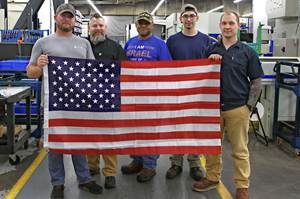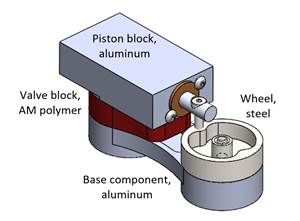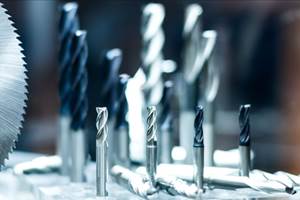When Disaster Strikes
If your equipment was damaged or destroyed by flood or fire, would you know what to do?
Share





Think about the various reasons why a machine tool might be out of service. Envisioned instances might range from the bearable—setting up a new job or performing routine maintenance—to the drastic—a machine crash.
Though a crash is certainly damaging in terms of repair cost and production loss, most shop managers know how to react to and recover from one. It's less likely that they'd know what to do if a lightning strike set their facility ablaze, or if the nearby creek overflowed its banks and flooded their building, destroying a number of high-dollar machines.
Mark Pennington, national service manager for Kentucky Rebuild Corp. (Independence, Kentucky), believes a number of shops haven't devoted sufficient forethought to such harsh scenarios. The hours and days immediately following a catastrophic event aren't the time to first ponder questions such as: How will we prove to our insurance adjuster what our equipment was worth? How do we replace a machine that's no longer being produced? What exactly does our insurance cover?
The key to a quick recovery from a tragic situation is knowing the answers to these and other questions before a tragedy occurs. Mr. Pennington has appraised damaged equipment for shops that hadn't thought of those questions, and in some cases, they weren't able to recover from the significant loss. Other shops he's visited had an effective recovery plan in place, which allowed them to bounce back quicker than if they were flying by the seat of their pants.
Because it's never too late to start planning for the worst, Mr. Pennington offers some food for though for proactive shops that see the value in developing their own disaster recovery plans.
Know what you have. How can you explain to an insurance claims adjuster what equipment you have—and, more importantly—what it is worth, if you don't really know yourself? Having an appraisal in hand for each big-ticket item can ensure that you get fair market value for any damaged machines. This independent, third-party opinion helps communicate to a claims adjuster—who likely doesn't know beans about machine tools—what a machine's true value is.
Document what you have. Knowing what you have means documenting what you have. The more documentation you have, the better off you'll be when it comes time to talk turkey with the claims adjuster. Documentation may include a master list of machines with their serial numbers, appraisals, maintenance records and proof that the value of a machine tool was increased in some way (as in the case of a control retrofit). Photos of equipment may also prove helpful to a shop's cause. Another wise, just-in-case measure would be to store duplicate documentation off-site.
And don't forget about all the ancillary equipment sitting around those expensive machine tools—indicators, material, loaded employee toolboxes and so on. Document as much of this as possible.
Know your machine options. Do you know what extras you purchased with a machine 5 years ago that you never used or perhaps removed? If you don't have a good record of exactly what you bought, what are the odds that you'll remember as you're freaking out just following a catastrophe? One of the first things an appraiser will want to know to determine fair market value is what options were purchased with a particular machine.
Know what is covered. Do you know what your insurance covers and what it doesn't cover? Will your insurance only cut a check in the amount of the replacement value of the machine tool? What about the production that will be lost because the machine is down? Lost production insurance can save a business, but Mr. Pennington estimates that only 50 percent of shops have it. In the event of an emergency, shops lacking this insurance may have to apply for a loan or take some other kind of action to make up for this lost stream of income. For a shop on the heels of a tragedy, this can really crank up the heat on a situation that's already white hot.
If your insurance does cover lost production, it is important to maintain records that will show a claims adjuster just how much money a machine's spindle makes per day. The machine's job schedule should also be presented to show the extent to which it is booked for the coming months. That will indicate the true value that the machine brings to the shop.
Consider the entire process. In some cases, it will make more sense to replace a machine rather than remanufacture it, as the cost to remanufacture certain damaged machines will be higher than a new machine. This can be a win-win situation for both shop and insurer. The insurance company pays less to settle the claim, and the shop comes out ahead by having a newer, more productive piece of equipment.
But it may pay to take a step back and look at the big process picture. Instead of focusing solely on an exact machine-to-machine replacement, take this opportunity to think about what other types of equipment or alternate process configurations might boost your overall production capability. Though the cost of this new equipment might be more than the insurance will pay to settle the claim for the damaged machine, you could come out ahead if some other, more flexible manufacturing scheme increases production or allows a quicker response to JIT delivery needs. Think of this situation as a potential silver lining in a tragic dark cloud.
Oil immediately. This bit of advice is less theoretical and more action-oriented. As soon as damage has been assessed and appropriate pictures and notes have been taken, clean machines and dump oil on them post-haste to try to save as many critical components as possible. Do this to all machines that may have received general water damage from a sprinkler system, for example, as well as those that incurred smoke damage. The corrosive effect of smoke can be just as potent as water.
Don't forget the office. Many companies are proactive in backing up computer files. If you're not, start doing it. Also, take a moment to picture your office under 3 feet of water. What would be damaged? Do you have a safety net in place for those items just a few feet off the floor that would be destroyed?
This final suggestion Mr. Pennington offers may be the sagest bit of advice: Apply the same precautionary measures you use for your business to your personal life. You just never know what's around the corner.
Related Content
Finding Skilled Labor Through Partnerships and Benefits
To combat the skilled labor shortage, this Top Shops honoree turned to partnerships and unique benefits to attract talented workers.
Read MoreWorkholding Fixtures Save Over 4,500 Hours of Labor Annually
All World Machinery Supply designs each fixture to minimize the number of operations, resulting in reduced handling and idle spindle time.
Read MoreSolve Worker Shortages With ACE Workforce Development
The America’s Cutting Edge (ACE) program is addressing the current shortage in trained and available workers by offering no-cost online and in-person training opportunities in CNC machining and metrology.
Read MoreAddressing the Manufacturing Labor Shortage Needs to Start Here
Student-run businesses focused on technical training for the trades are taking root across the U.S. Can we — should we — leverage their regional successes into a nationwide platform?
Read MoreRead Next
Building Out a Foundation for Student Machinists
Autodesk and Haas have teamed up to produce an introductory course for students that covers the basics of CAD, CAM and CNC while providing them with a portfolio part.
Read MoreSetting Up the Building Blocks for a Digital Factory
Woodward Inc. spent over a year developing an API to connect machines to its digital factory. Caron Engineering’s MiConnect has cut most of this process while also granting the shop greater access to machine information.
Read MoreRegistration Now Open for the Precision Machining Technology Show (PMTS) 2025
The precision machining industry’s premier event returns to Cleveland, OH, April 1-3.
Read More






















.jpg;maxWidth=300;quality=90)















